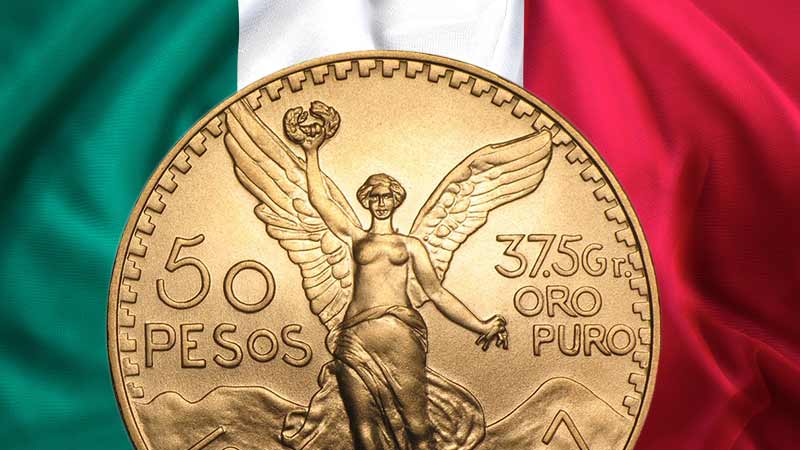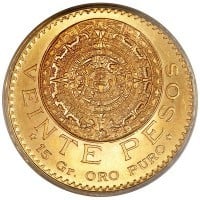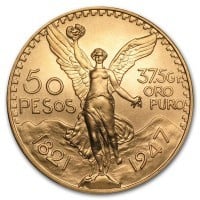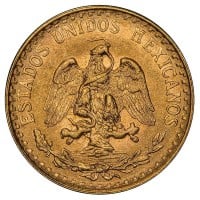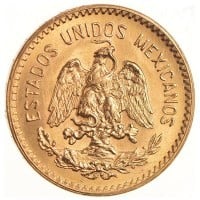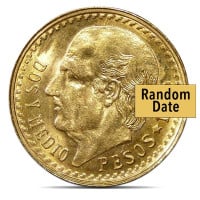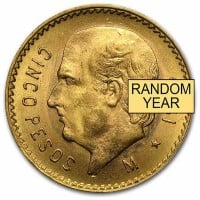Mexican Gold Pesos
| Qty | Price Each |
|---|---|
| 1 - 19 | $1,280.12 |
| 20 - 50 | $1,268.79 |
| 51+ | Call for pricing |
|
|
|
| Qty | Price Each |
|---|---|
| 1 - 9 | $3,016.10 |
| 10 - 39 | $2,973.61 |
| 40+ | Call for pricing |
|
|
|
| Qty | Price Each |
|---|---|
| 1 - 29 | $173.21 |
| 30+ | Call for pricing |
|
|
|
| Qty | Price Each |
|---|---|
| 1 - 9 | $639.93 |
| 10 - 39 | $628.60 |
| 40 - 80 | $617.28 |
| 81+ | Call for pricing |
| Qty | Price Each |
|---|---|
| 1 - 19 | $184.13 |
| 20 - 50 | $177.05 |
| 51+ | Call for pricing |
|
|
|
| Qty | Price Each |
|---|---|
| 1 - 19 | $342.76 |
| 20 - 50 | $334.26 |
| 51 - 80 | $325.76 |
| 81+ | Call for pricing |
|
|
|
Buy Mexican Gold Pesos
The Mexican Mint, also known in Spanish as La Casa de la Moneda, is the oldest operating mint in the Americas. Established on May 11, 1535, this mint has demonstrated it can produce some of the most popular coins in the world. Initially, the currency created by the Mint of Mexico was the Spanish piece of eight-real (aka. real de a ocho, reales, Spanish dollar, Spanish milled dollar) on which the currency of the United States was also based.
In 1497, the peso was introduced as a Latin American alternative to the Spanish dollar at 83⁄8 pesos to a Castilian mark (230.0465 grams) of silver 134/144 fine (25.56 g fine silver). The word peso in Spanish means “weight.” The origin of the word peso is from cutting off an exact weight of pure silver from a bar of silver, and then this piece was hammered into a rudimentary coin.
By 1730, Spanish-ruled Mexico was forced to comply with the new coinage laws of Spain and changed the design, weight, size, and fineness of the Mexican silver peso. The new specifications were 8.5 pesos to a mark (27.064 g), 0.9167 fine, or 24.809 grams of fine silver, and this lasted for around 40 years.
A final alteration was made to the peso in 1772, by changing the peso from 11/12 fine to 130/144 = 0.9028 (fine silver 24.443 g). However, until Mexico’s independence from Spain in 1821, the actual fineness of the silver peso was closer to 89.6% fine; and in 1821 that was restored to 90.28% fine.
In Mexico, when referencing a coin’s obverse or reverse, instead of saying, “Heads or Tails,” they say in Spanish, “Aguila o Sol,” which translates to “Eagle or Sun.” Many Mexican coin designs have the Coat of Arms of Mexico which includes the national symbol of a golden eagle on the obverse side (heads).
Some sites confuse these sides likely due to translations and cultural differences. For example in the United States, the US Mint typically puts a headed figure on the obverse side, which gives it the colloquialism of “heads.” In Mexican coinage, even if there is a headed figure on one side, the side that has the depiction of the eagle or the symbol of the national arms is the obverse side (heads).
Until the minting of the South Africa Mint and Rand Refinery’s gold Krugerrand in 1967, the gold peso was considered the purest and most desired gold bullion coins throughout the world.
As a denomination currency in both silver and gold forms, the coinage ranged in face value from 2 pesos up to 50 pesos, with the 50 pesos (MXP) gold bullion coin being the most famous.
2 Pesos
The 2 pesos (dos pesos) gold coin began being minted in 1919, producing a mintage of 1,670,000 gold coins that year, but ended after just one year in 1920. Minting of the 2 pesos gold coins was restarted in 1944 and continued through 1948. Then in 1951, the Mexican Mint began issuing restrike coins with a 1945 date. In total, nearly 5 million of the 1945-restrike coins were issued.
The 2 pesos gold coin has an actual gold weight (AGW) of 0.0482 Troy ounces (~ 1.5 grams) of 90% pure gold (.900 fine) while the remainder alloy of the coin is 10% copper. The overall weight of the 2 pesos Mexican gold bullion coin weighs around 1.667 grams. The diameter of the dos pesos gold coin is typically estimated around 12.85 mm (0.50590551 inches) to 13 mm (0.511811 inches), and the thickness is 1.02 mm (0.04015748 inches). The edges are reeded to prevent clipping and reduce counterfeiting.
The obverse side of the dos pesos gold coin has the Mexican golden eagle clutching a snake in its beak and talons over a cactus, while the eagle looks upward. The legend of the coin has the words “Estados Unidos Mexicanos” above the eagle. Below the cactus are a branch of oak leaves and a branch of olive leaves, tied together with a bow. Along the fin and face of the coin is an Aztec brick design that resembles traditional chain designs.
The reverse side (tails) of the 2 pesos gold bullion coin has a semicircle of a laurel wreath tied with a bow in the center that has a medal in the shape of an M hanging from it. At the top of the coin, in between the pointed ends of the wreath, is the coin’s mintage year, which is not necessarily when the coin was originally minted as many restrikes were made. In the center of the reverse side are the words “Dos Pesos” which is Spanish for the face value “two pesos.” Along the edge of the fin of the coin includes the Aztec brick pattern as on the obverse.
2.5 Pesos
The 2.5 pesos coin (dos y medio) began minting in 1918, producing a mintage of 1,704,000 gold coins the first year. In 1919, the 2.5 pesos gold coins had a mintage of 984,000. Then, just like the 2 pesos, the 2.5 pesos stopped production in 1920 and did not begin minting again until 1944.
The 2.5 pesos gold coin has an AGW of 0.0603 Troy ounces (~1.9 grams) of 90% pure gold (.900 fine) while the remainder alloy of the coin is 10% copper. The overall weight of the 2.5 pesos Mexican gold bullion coin weighs around 2.0833 grams. The diameter of the dos y medio pesos gold coin is around 15.5 mm (0.6102362 inches) and the thickness is around 0.86 mm (0.0338583 inches) to 0.9 mm (0.0354331 inches). The edges are reeded to prevent clipping and reduce counterfeiting.
The obverse side of the 2.5 pesos gold coin has the Mexican golden eagle clutching a snake in its beak and talons over a cactus, while the eagle looks upward. The legend of the coin has the words “Estados Unidos Mexicanos” above the eagle. Below the cactus are a branch of oak leaves and a branch of olive leaves, tied together with a bow. Along the fin and face of the coin is an Aztec brick design that resembles traditional chain designs.
The reverse side of the 2.5 pesos gold coin features the bust of Miguel Hidalgo y Costilla, a spearhead leader in the movement for Mexico's independence (i.e. The Mexcian War of Independence from 1810 to 1821). His full name is rather long: Don Miguel Gregorio Antonio Ignacio Hidalgo y Costilla Gallaga Mandarte y Villaseñor.
Hidalgo is often referred to as “the Father of the Nation” (Mexico). He lived from 1753 to 1811 and led an army of 90,000 poor farmers and other civilians against the Spanish army. He was betrayed, captured, and executed. However, his movement carried on to eventual victory. Hidalgo's image also struck on other denominations of the peso coin. The denomination - "Dos y Medio Pesos" is displayed along with a five-point star and the coin's date. Along the fin is the Aztec brick pattern.
5 Pesos
The 5 pesos gold coin began minting in 1905, continued through 1907, started and stopped again in 1910; again from 1918 to 1920; restrikes from 1955 to 1972; matte restrikes from 1996; and 1955-restrikes from 2000 to 2017 with 111,400 pieces. From 1955 to 1972 a total of 1,767,645 gold coins were restruck and also dated as 1955.
The 5 pesos gold coin has an actual gold weight (AGW) of 0.1206 Troy ounces (~ 3.751 grams) of 90% pure gold (.900 fine) while the remainder alloy of the coin is 10% copper. The overall weight of the 5 pesos Mexican gold bullion coin weighs around 4.1666 grams. The diameter of the dos pesos gold coin is around 19 mm (0.748031 inches), and the thickness is estimated as 1.14 mm (0.04488189 inches). The edges are reeded to prevent clipping and reduce counterfeiting.
The obverse side of the 5 pesos gold coin has the Mexican golden eagle clutching a snake in its beak and talons over a cactus, while the eagle looks upward. The legend of the coin has the words “Estados Unidos Mexicanos” above the eagle. Below the cactus are a branch of oak leaves and a branch of olive leaves, tied together with a bow. Along the fin and face of the coin is an Aztec brick design that resembles traditional chain designs.
The reverse side of the cinco pesos gold bullion coin features a bust of Miguel Hidalgo. Included are the letter M, a five-point star, and the year the coin represents. Along the fin is the Aztec brick pattern.
10 Pesos
The 10 pesos gold bullion coin began minting in 1905, continued through 1908, started and stopped again in 1910; again from 1916 to 1920; 1959; 1959-restrikes from 1961 to 1972; matte restrikes from 1996; and 1959-restrikes from 2000 to 2017 with 84,300 pieces. From 1961 to 1972 a total of 954,983 gold coins were restruck and also dated as 1959.
The diez pesos gold bullion coin has an actual gold weight (AGW) of 0.2411 Troy ounces (~ 7.5 grams) of 90% pure gold (.900 fine) while the remainder alloy of the coin is 10% copper. The overall weight of the 10 pesos Mexican gold bullion coin weighs around 8.3333 grams. The diameter of the 10 pesos gold coin is around 22.5 mm (0.8858268 inches), and the thickness is estimated as 1.4 mm (0.0551181 inches). The edges are reeded to prevent clipping and reduce counterfeiting.
The obverse side of the 10 pesos gold coin has the Mexican golden eagle clutching a snake in its beak and talons over a cactus, while the eagle looks upward. The legend of the coin has the words “Estados Unidos Mexicanos” above the eagle. Below the cactus are a branch of oak leaves and a branch of olive leaves, tied together with a bow. Along the fin and face of the coin is an Aztec brick design that resembles traditional chain designs.
The reverse side of the diez pesos gold bullion coin features a bust of Miguel Hidalgo. Included are the letter M, a five-point star, and the year the coin represents. Along the fin is the Aztec brick pattern.
20 Pesos
The 20 pesos gold bullion coin began minting in 1917, continued through 1921, started and stopped again in 1959; 1959-restrikes from 1960 to 1971; matte restrikes from 1996; and 1959-restrikes from 2000 to 2017 with 113,300 pieces. From 1960 to 1971 a total of 1,158,414 gold coins were restruck and also dated as 1959.
The veinte pesos gold bullion coin has an actual gold weight (AGW) of 0.4823 Troy ounces (~ 15 grams) of 90% pure gold (.900 fine) while the remainder alloy of the coin is 10% copper. The overall weight of the 20 pesos Mexican gold bullion coin weighs around 16.6666 grams which is exactly twice the weight of the 10 pesos gold coin. The diameter of the 20 pesos gold coin is around 27.5 mm (1.082677 inches), and the thickness is estimated as 2.03 mm (0.07992126 inches). The edges are reeded to prevent clipping and reduce counterfeiting.
The obverse side of the veinte pesos gold coin has the Mexican golden eagle clutching a snake in its beak and talons over a cactus (more flattened than the smaller denominations), while the eagle looks downward. The legend of the coin has the words “Estados Unidos Mexicanos” above the eagle. Below the cactus are a branch of oak leaves and a branch of olive leaves, tied together with a less prominent bow than smaller denominations.
Along the fin and face of the coin is an Aztec brick design. Between the golden eagle’s tailfeathers and the word Mexicanos is where the year is located and at a sharp 45-degree angle. Interestingly, the word años (sometimes written informally as años) means years in Spanish, which is convenient that the year is written closest to that part of the word as in Mexic-años.
The reverse side of the 20 pesos gold coin displays the Cuauhxicalli Eagle Bowl Aztec Calendar, also known as a Sun Stone (or sunstone). This circular sun calendar is towards the top of the coin, while below it displays the words “Veinte Pesos” and a tapering of letter font sizes on both ends (start and end of wording) while the larger font is in the center. Below this are the words “15 Gr. Oro Puro” which translates from Spanish to English as “15 Grams Pure Gold” with a five-point star on the left and right of these words. Along the fin is the Aztec brick pattern.
50 Pesos
The 50 pesos gold bullion coin, commonly referred to as the Centenario (which translates as Centenary), began minting in 1921 to commemorate the 100th anniversary of Mexico’s independence. Minting continued through 1931 and did not begin minting again until 1944; again from 1944 through 1947; and from 1949 through 1972 with 1947-restrikes; and 1996 with 1947-restrikes in matte finishes; and from 2000 through 2017 with 1947-restrikes. From 1949 to 1972, a total of 3,975,654 coins were minted; from 2000 to 2017, a total of 473,900 coins were minted.
The cincuenta pesos gold bullion coin has an actual gold weight (AGW) of 1.2057 Troy ounces (~ 37.5 grams) of 90% pure gold (.900 fine) while the remainder alloy of the coin is 10% copper. The overall weight of the 50 pesos Mexican gold bullion coin is around 41.6666 grams. The diameter of the 50 pesos gold coin is around 37 mm (1.45669 inches), and the thickness is estimated as 2.69 mm (0.1059055 inches). The edges are reeded to prevent clipping and reduce counterfeiting.
The obverse side of the cincuenta pesos gold coin has the Mexican golden eagle clutching a snake in its beak and talons over a cactus, while the eagle looks upward. The legend of the coin has the words “Estados Unidos Mexicanos” above the eagle. Below the cactus are a branch of oak leaves and a branch of olive leaves, tied together with a bow. Along the fin and face of the coin is an Aztec brick design.
The reverse side of this centennial Mexican Independence commemorative coin has the image of a personified winged victory (also known as el angel, el angel de la independencia, angel of freedom, etc.). This historic design was later used in the Mexican coin series known as the Libertad. Except in this version, she faces the viewer square and directly, as opposed to askew to a profile.
The bare-breasted angel holds a classical Roman laureate crown (crown made from laurel leaves) in her right hand raised high, and in her left hand pointing downward holding broken chains. Her gown is delicately draped around her hips and covers most of her bottom half, although the material depicted appears sheer. Her wings are spread behind her as she appears to be landing or standing on one foot on a rock, similar to the famous statue of The Winged Nike.
Along the top of this reverse side is the Aztec brick design that is broken halfway down the coin by a mountainous landscape, almost as though the traditional chain design was broken. To the angel’s left is “50 Pesos” and to her right is “37.5 Gr. Oro Puro” which translates as “37.5 grams Pure Gold.” On the left side of the mountain is the year 1821, which is the year of Mexican Independence from Spain. On the right side of the mountain is the year of mintage (which is more likely a restrike than an original from the year indicated).
Buying and Selling Mexican Gold Coins
When buying or selling Mexican gold pesos, it is important to first know a few key things. It is important to know the current gold spot price to get an idea of the melt value of a 90% pure gold coin. Secondly, it is a good idea to know the average, fair, asking price of each denomination. Thirdly, it is a good idea to know the average premium added - this is the standard overhead costs that companies add to the melt value, which makes the total price. Finally, it is important to only do business with a reputable online bullion dealer.
Money Metals Exchange is one of the leading online bullion dealers in the United States of America. In fact, Money Metals Exchange has been awarded as the Best Overall Precious Metals Dealer by Investopedia.
This award title was given to Money Metals for multiple reasons including top-level customer service, remaining informative with having spot prices listed publicly on the website 24/7 and being transparent with listed premiums and deals for every purchase. Money Metals offers competitive pricing, unmatched knowledge, and impeccable customer care.
Money Metals Exchange has been in business since 2010 while maintaining an A+ rating with the Better Business Bureau (BBB) and receiving thousands of 5-star reviews from satisfied customers all over the U.S.
If you have any questions (FAQ) about the Mexican gold pesos, a particular denomination, selling your gold coins to MMX, shipping, insurance, delivery, sending gifts, payment methods, past orders, alternative gold coins for investing or to hedge against inflation, gold bullion coins, gold bars, gold rounds, gold ingots, gold jewelry, or anything else, please call our customer service at our phone number: 1-800-800-1865




